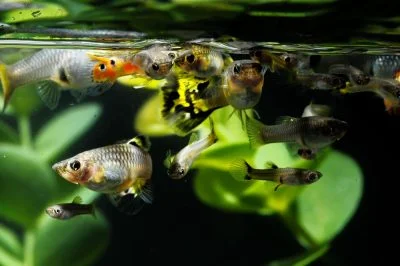Thank you for visiting! By the way… any links on this page that lead to products on Amazon and other stores/partners are affiliate links Aquarium Store Depot earns a commission if you make a purchase.
Many aquarists, including myself, jumped out of their skins when they got the answer to one of the most asked questions in the aquarium hobby; “Do fish sleep?”
And you may wonder, “Who asks such questions? Kindergarten Students?” Actually, no!
However, trivial it may sound, the phenomenon of sleep in fish is very different and fascinating than humans and other animals. Therefore, it is completely normal to ask a question as basic as, “Do fish sleep?”
The answer is, yes, fish sleep like all other species, but in a very different manner.
And today, in this article, we’ll cover everything about how a fish sleep.
So, stay with me!
Do fish sleep?
As mentioned earlier, like all living beings, fish sleep too. However, their sleep is different than the sleep of mammals birds, or other animals. That’s because they don’t need a land to rest their body, they don’t need beds, covers, or even eyelids. Basically, most fish cannot even close their eyes (except sharks). Check out the video above from our YouTube Channel and follow along with our blog post.
The Definition
To discuss the topic, we need to talk about the actual definition of sleep so we have the proper frameset when talking about our pets. Here is the definition:
Sleep has a simple definition that includes closed eyelids and a particular brainwave pattern in the neocortex – which makes sleep easy to determine for most animals. However, this makes it difficult for fish because they have neither a neocortex or eyelids.
The University of Zurith did a study of over 150 animals to determine if all animals sleep1. They determined that all animal sleeps – even microbes! This study used Henri Pieron’s definition of sleep. There are 4 key characteristics:
- A species specific sleep posture
- The maintenance of behavioral quiescence (inactivity/dormancy)
- Elevation of arousal threshold (takes effort to get organism to react)
- Reversibility with stimulation (we can wake them up)
Fish mostly sleep in the form of activity reduction and lower response to stimulus. So, next time, when you find your fish floating in the tank with minimal body movement and changed body coloration, know that it is just sleeping.
Stanford researchers have found that the freshwater zebrafish slumber much the way we do: They display a type of slow-wave sleep and a type of REM (also known as paradoxical) sleep. The discovery suggests that these neural sleep signatures — present in mammals, reptiles, and birds — emerged at least 450 million years ago.
It is crucial to understand that fish sleep doesn’t include rapid eye movement (REM sleep), which is associated with dreaming in mammals. In fish species, sleep only occurs with reduced activity levels to save energy and undergo physiological changes to restore or rejuvenate the body.
Some diurnal species (fish that sleep at night) will actually be active during day and night if they are doing something very involved such as migration. You will see this with Tilapia and even eels when they are trying to mate.
Fun Fact: Zebrafish species can exhibit two sleep cycles like most higher vertebrates.
Mindblowing Behaviors Of Dolphins

Some animals like marine mammals exhibit even stranger behavior. Dolphins do not have gills and need to surface to breathe. They can maintain a sleep cycle by shutting off half the hemispheres of their brain. This is known as unihemispheric slow-wave sleep. While one half of the brain sleeps, the other half keeps them swimming and tracks their need to surface for air while the other half sleeps.
Other behaviors from dolphins include “logging” which is them floating to the surface on their sides like a log to rest and still breathe air.
How do fish species sleep?
Like other animals that require sleep to stay healthy, fish also need sleep to undergo many bodily changes. However, fish sleep differs from other animals. For example, most fish are sleeping while hovering in the water or lying on the sand or substrate, reducing their activity levels. In such conditions, they conserve energy and their metabolic rate decreases they will not respond to external stimuli like usual. Also, the fact that fish do not have eyelids, makes it challenging to figure out if the fish are sleeping.
Furthermore, many fish seek out shelters or hiding places when they are in resting mode to protect themselves from predators. Therefore, adding crevices, under rocks, and driftwood is recommended to keep in your aquariums.
How does parrot fish sleep?
Parrotfish sleep in a very interesting way. They make their own cocoons in the form of sleeping bag by secreting their mucous around them every night, protecting them from predators and parasites.
How do fish from fast moving water sleep?
Many different fish species, including pelagic fish and sharks, are constantly moving even when they are resting to ensure a constant water flow and oxygen supply over the gills.
Other than that, there are several fish species with swim bladder that maintain buoyancy, so even when the fish sleeps, it still floats in the water.
How can you tell when your aquatic pet is sleeping?

Chances are your fish are sleeping, but showing no apparent signs of sleep because obviously, they don’t human sleep behaviors.
Therefore, it is necessary to figure out how your fish sleeps and provide adequate night time to maintain overall health. Like humans, fish may show signs of sleep deprivation. Thus, provide adjustable aquarium light to understand your fish’s sleep patterns and allow your fish to sleep soundly.
Since fish do not have eyelids, you cannot judge whether it’s sleeping. However, there are a few ways to spot a sleeping fish in your aquarium.
Location
Look out for fish that are resting on the bottom or just hovering without being active. If you have a school of fish, you may notice a small group resting somewhere around the corner. Other fish may be sleeping or resting in or around tank decorations or caves.
Signs of deprivation
There are thousands of research done on sleep deprivation in many invertebrates and other mammals, but there is little available data on fish. In fact, almost all studies have been conducted on some species, like zebrafish, to know the potential signs of sleep deprivation2.
- One of the common signs is increased resting
- No response to external stimuli even to potential environmental threats
- Changes in activity patterns
- Difficulty in learning and memory tasks
- Potential stress due to increased cortisol levels
Note that 4 and 5 are hard to observe in the tank. However, in the studies cited, fish can suffer from insomnia and can develop sleeping disorders. Their sleep is also regulated by Melatonin3.
How Do I Make Sure They Get Enough?
One of the easiest ways to let your fish fall asleep is by putting your lights on a timer. This provides your fish with a consistent day and night routine like you would normally do for other animals. Avoid having your fish in constant light.
It is also recommended to provide hiding places and cover in your aquarium in the form of rocks, caves, driftwood, and other tank decors or aquarium plants, so your fish feels safe and secure in the aquarium while resting. For example, fish living near coral reefs love to hide during the nighttime. Thus, replicate their environment for a better and deeper sleep.
During their sleep state, avoid slamming the doors or watching TV at loud volume. Also, do not allow your pets to go near the tank when the fish are sleeping.
When transitioning from dark periods to daytime, I recommend gradually brightening the aquarium lights to stimulate natural sleep cycles.
FAQs
How do you know if a fish is sleeping?
There are a few signs of a sleeping fish:
- Inactive or motionless during periods of time
- Laying on the bottom or just hovering on any aquarium object
- Not responding to any external stimuli, even food.
Do Fish Suffer From Sleep Disorder?
Even though there’s not a lot of research material available on sleep disorders in fish, however, studies on zebra danios, suggest that the fish may sleep more when there’s a sleep loss.
Do fish swim when they sleep?
It depends on the fish species and the type of sleep you get. For example, many fish are almost completely inactive during resting period or they just hover in one place or lie on the substrate. While other fish are continuous swimmers, especially those living in fast-flowing waters, such as Pelagic fish. However, some fish find hiding spots so they can rest without swimming between rocks, corals, or other tank decors.
Many species of catfish or rays rest on the bottom during resting periods.
Do fish close their eyes?
No. Fish do not close their eyes during sleep because they don’t have eyelids.
How long do fish sleep at a time?
Aquarium fish may sleep for around 8 to 12 hours, depending on the aquarium light and other factors.
Do fish sleep or close their eyes?
Yes, like all other animals, fish do sleep. No, they don’t close their eyes because they don’t have eyelids.
Final Thoughts
Sleep is important for the well-being of animals, including fish. However, fish don’t sleep in a conventional way like many animals, and they do not follow circadian rhythm as strictly as humans do. Still, they put their bodies at rest and adjust their sleep routine to water temperature, food, migration patterns, and other factors.
- About the Author
- Latest Posts
I’m thrilled that you found Aquarium Store Depot! Here you’ll find information on fish, aquariums, and all things aquatics related. I’m a hobbyist (being doing this since I was 11) and here to help other hobbyists thrive with their aquariums! I adhere to a high quality Editorial Process and Review products with real life field usage and practical analysis.





